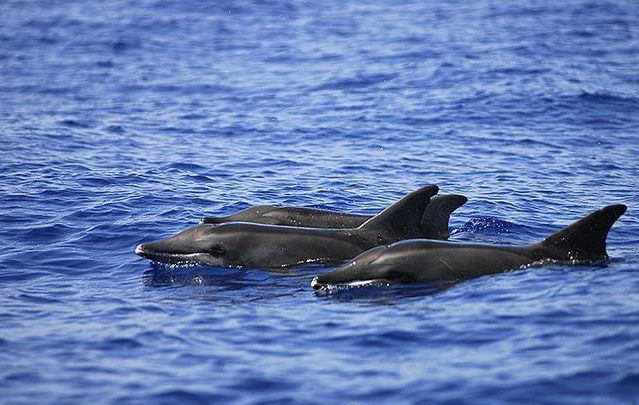Steno bredanensis
IUCN
LCBasic Information
Scientific classification
- name:Steno bredanensis
- Scientific Name:Steno bredanensis,Rough-toothed dolphin,Long-beaked dolphin, wrinkled-toothed dolphin
- Outline:Cetacea
- Family:Odontoceti Delphinidae R.dolphin
Vital signs
- length:223-275cm
- Weight:90-155kg
- lifetime:25-45years
Feature
There are vertical fine wrinkles or ridges on the tooth surface, which is the origin of the Chinese name "rough teeth"
Distribution and Habitat
Distributed in tropical to warm temperate waters of the Atlantic Ocean, Indian Ocean, and Southeast Pacific Ocean, occasionally entering colder waters.
Main distribution countries and regions (seas): Algeria, American Samoa, Angola, Anguilla, Antigua and Barbuda, Aruba, Australia, Bahamas, Bangladesh, Barbados, Belize, Benin, Brazil, British Indian Ocean Territory, Brunei Darussalam, Cambodia, Cameroon, Cape Verde, Cayman Islands, Chile, China, Cocos Island, Colombia, Congo, Comoros, Cook Islands, Costa Rica, Côte d'Ivoire, Cuba, Djibouti, Dominican Republic Mexico, Ecuador, El Salvador, Equatorial Guinea, Fiji, France, French Guiana, French Polynesia, Gabon, Gambia, Ghana, Gibraltar, Crete, Grenada, Guadeloupe, Guam, Guatemala, Guinea, Guinea-Bissau, Guyana, Haiti, Honduras, Hong Kong, India, Indonesia, Iran, Israel, Italy (Sardinia, Sicily), Jamaica, Japan, Kenya, Kiribati, Kuwait, Libya Libya, Madagascar, Malaysia, Maldives, Marshall Islands, Martinique, Mauritania, Mexico,
Appearance
Adult rough-toothed dolphins are 223-275 cm long. The body is spindle-shaped, with the dorsal fin being the thickest. The dorsal fin is high and triangular. The rear edge is sickle-shaped and concave. The first and second cervical vertebrae are fused, and 4-5 of the 13 pairs of ribs are bicuspid ribs. The sternum consists of 4 segments. The beak is particularly narrow and long, with the beak length being more than 3 times the beak width, and the ratio of beak length to body length is the largest among dolphins. The flippers are very long and have 5 fingers. There are 20-27 large teeth on each side of the upper and lower jaws, and there are longitudinal wrinkles on the crown of the teeth. Most of its skin is charcoal gray or black, with irregular white spots on the ventral surface. In addition, there are white, light red, and ivory spots on the body surface, which are scars left after being parasitized by protozoa and bacteria.
Carnivorous. It dives to prey on cephalopods and large f
Details
Rough-toothed dolphin, a dolphin with special teeth.

Rough-toothed dolphins usually form a "pod" (a term for groups of dolphins, seals or whales) of 10 to 30, and there are also "pods" of up to 160, which contain 8 smaller groups. Occasionally swims with pilot whales, bottlenose dolphins, spotted dolphins, and long-beaked dolphins. Good diver, can stay underwater for 15 minutes. Swims fast, with dorsal fin clearly visible when riding waves on the surface. Can do water "surfing" and bow riding, but not as common as other tropical dolphins.
The most common behaviors of rough-toothed dolphins are patrolling, socializing (among "pod members"), foraging, sleeping, playing with things, and circling. Studies of their natural habitats found that cruising accounted for 26.6% of all common behaviors, while cruising with the boat accounted for 17.5%; socializing accounted for 11% of the total time, including physical contact between "pod" members and swimming towards each other on the water surface; foraging accounted for 14.9%, which involved chasing fish, diving for fish, and forming feeding rings; hibernation accounted for 9.7%, which was characterized by drifting in a fixed direction; circling accounted for 9%, without physical contact between "pod" members, just swimming in a stable place on the water surface; playing with objects (interacting with external objects) accounted for 7.1%; and other activities accounted for the remaining 3.8% of activity time.
Rough-toothed dolphins show characteristics of sexual dimorphism, with mature males slightly longer than females, and the fastest growth period for both sexes is the first 5 years after birth. Females reach maturity at 9-10 years old, 212-217 cm in length, and 101-108 kg in weight; males reach sexual maturity at 5-10 years old, about 216 cm in length, and 92-102 kg in weight. Newborn dolphins are 1-1.3 meters long. Within 3 days after birth, the mother successfully raises the dolphins underwater and stays with them. The dolphins rest for about an hour near noon, and when they are 2 months old, they start to eat fish and reduce the time of raising them. When the female dolphins protect their calves, they swim close to them and use their bodies to separate the calves from other dolphins. This kind of parenting behavior is more common among rough-toothed dolphins. They are also believed to have reciprocal altruistic behaviors, such as swimming under injured dolphins to help the dolphins above float to the surface to breathe. Rough-toothed dolphins have also been found to linger around the bodies of deceased dolphins, which can last from a few hours to a few days.
According to the 1993 population statistics, there were about 146,000 rough-toothed dolphins living in the tropical waters of the eastern Pacific Ocean. According to the 2008 survey data, there were about 2,746 in the northern Gulf of Mexico, of which 1,238 lived on the coastal continental shelf. In 2006, the US National Marine Fisheries Service estimated that the population in the waters around Hawaii was 19,904.
The artificial breeding of rough-toothed dolphins has been successful. After being domesticated, they can perform acrobatics and are even more flexible than bottlenose dolphins. Because they are rich in fat, they were once hunted in large numbers for oil refining, which led to a decline in their population.
Listed in Appendix II of the Convention on International Trade in Endangered Species of Wild Fauna and Flora (CITES).
Listed in the 2012 Red List of Endangered Species of the World Conservation Union (IUCN) ver 3.1 - Least Concern (LC).
Listed in the second level of the List of Wildlife under National Key Protection in China.
Protect wildlife and eliminate game.
Maintaining ecological balance is everyone's responsibility!








